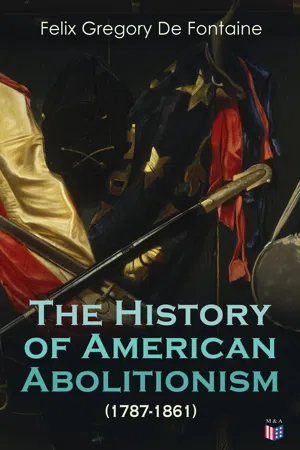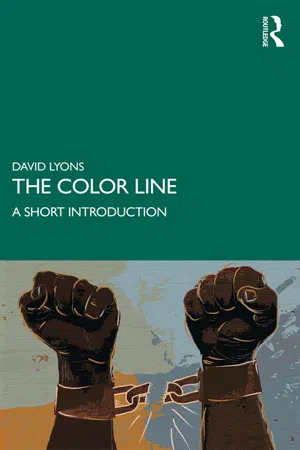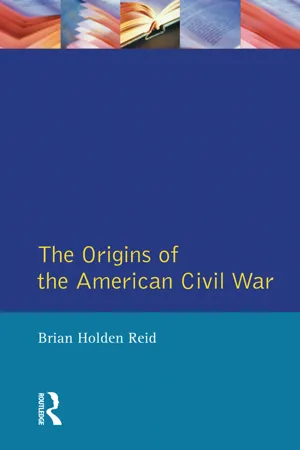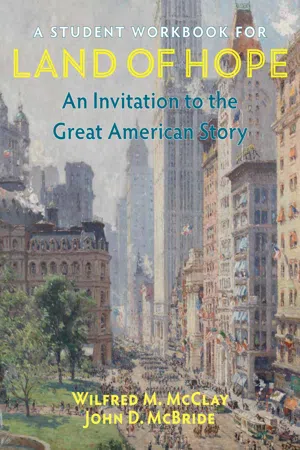Compromise of 1850
The Compromise of 1850 was a package of laws passed by the US Congress to address the issue of slavery in the newly acquired territories from the Mexican-American War. It included the admission of California as a free state, the organization of the territories of New Mexico and Utah without restrictions on slavery, the abolition of the slave trade in Washington D.C., and the Fugitive Slave Act.
7 Key excerpts on "Compromise of 1850"
- eBook - ePub
The Laws That Shaped America
Fifteen Acts of Congress and Their Lasting Impact
- Dennis W. Johnson(Author)
- 2009(Publication Date)
- Routledge(Publisher)
...First, California was admitted into the Union as a free state. Second, the territorial governments and boundaries were established for Utah and New Mexico, and their status as free or slave states would be determined by the territories themselves through their constitutions. Third, the slave trade would be abolished in the District of Columbia by 1851. Fourth, the 1793 Fugitive Slave Act was amended by removing cases from the states and appointing federal commissioners to conduct hearings and issue arrest warrants; it also prohibited slaves from having the right of trial by jury or testifying on their own behalf. Finally, the Texas–New Mexico boundary was established, and Texas was paid $10 million in compensation for its loss of New Mexico lands. A fatigued Stephen Douglas summed up the compromise: “The measures are right in themselves, and collectively constitute one grand scheme of conciliation and adjustment …. Neither section has triumphed over the other. The North has not surrendered to the South, nor has the South made any humiliating concessions to the North.” 84 Millard Fillmore, in his first annual message to Congress in December 1850, praised the Compromise, assuring the country that it was the “final and irrevocable” settlement of the sectional tensions. 85 The Compromise bought a measure of peace and bought some time. However, it did not fully accomplish what it set out to do: in California, a free state, the senators during the 1850s were pro-southern; slavery continued to exist in Utah and New Mexico; the slave trade was not fully shut down in the District of Columbia; and Texas creditors were not paid immediately. 86 One of the sorest points of contention was the Fugitive Slave Act. For southerners, the principle of states’ rights was a basic article of faith: the federal government could not and should not tell the states what to do. For southerners, states’ rights meant the federal government should not interfere with slavery, pure and simple...
- eBook - ePub
The History of American Abolitionism (1787-1861)
Four Great Epochs: Narratives of the Ordinance of 1787, Compromise of 1820, Annexation of Texas, Mexican War, Abolition Riots, Slave Rescues, Compromise of 1850, Kansas Bill of 1854
- Felix Gregory De Fontaine(Author)
- 2018(Publication Date)
- Madison & Adams Press(Publisher)
...CHAPTER VII THE FOURTH EPOCH Table of Contents History of the Compromise Measures of 1850 — Cessation of the Agitation in Congress — The Fugitive Slave Law in the North — Repeal of the Missouri Compromise — Narrative of the Difficulties in Kansas — Disunion Convention in Massachusetts. The next important move upon the political chessboard with reference to slavery preceded the adoption of the celebrated measures familiarly known by the above title, or as the “Omnibus Bill of 1850.” The events which led to this measure may be briefly stated thus: — Ever since 1848, a storm had been lowering in the political horizon of the country on the slavery question, threatening to dissolve the Union, which necessarily burst over Congress in Legislating for the new Territories brought into the Union by the result of the Mexican war. Probably no subject has been presented since the adoption of the federal constitution involving questions of such deep and vital importance to the inhabitants of the different States of the confederacy as that in reference to the territory thus acquired. Not only was the sentiment avowed of the existence of danger to the Union, but in various quarters was heard an open and undisguised declaration of a necessity and desire for its dissolution. General Taylor was elected, a new administration came into power, and being somewhat identified with the Northern anti-slavery elements, as opposed to the Democratic party, a tremendous agitation was at once created, and the whole question of slavery thrown again into the crucible. The Thirtieth Congress had adjourned without organizing the new Territories, or settling any great principle as to their future government and destiny. California had gone forth without asking leave, formed a State government prohibiting slavery, and put its machinery in operation. Utah was governed by a high and arbitrary spiritual despotism, and New Mexico was under military rule, ordered from the seat of federal power at Washington...
- eBook - ePub
The Color Line
A Short Introduction
- David Lyons(Author)
- 2019(Publication Date)
- Routledge(Publisher)
...9 SECTIONAL CONFLICTS AND THE COLOR LINE Until the Civil War began, Northern and Southern representatives in Congress continued to worry that their respective regions would be outvoted on crucial issues such as tariffs and how much of the newly acquired territory would be open to slavery. Attempts to limit slave territory did not generally signify a rejection of the color line. Many white persons in the increasingly crowded East wanted some land of their own in the West – and did not wish to share the territory with free African Americans. Northern business wanted to limit the number of new slave states and their impact on federal legislation. Some measures seem intended to preserve the balance of power. In 1820, for example, Congress reached the Missouri Compromise, which banned slavery in new states and territories that lay north of the 36° 30’ parallel, except for the new state of Missouri, which protruded above the compromise line but allowed slavery. The issue was reopened after the Mexican War (1846–48) when the US acquired extensive territory from which several new states would presumably emerge. In addition, Texas, a recently annexed slave state, claimed land that lay north of the compromise line. And what was to be done about California, which straddled the 36° 30’ parallel? A compromise was reached in 1850: California would be admitted as a free state. Texas would give up its claim to territory north of the compromise line in return for the federal government’s assuming the state’s debt. To make the slave trade less visible to foreign visitors, slave auctions – the sale and purchase of human beings – would no longer be held in the District of Columbia, but part of the district would be returned to Virginia, where the slave trade could continue unimpeded. The remainder of the Mexican Cession (less California and Texas) would become the territories of New Mexico and Utah (each much larger than the state that later acquired its territorial name)...
- eBook - ePub
- Brian Holden Reid(Author)
- 2014(Publication Date)
- Routledge(Publisher)
...In truth, the Compromise of 1850 did not ‘settle’, once and for all, the contentious issue of slavery. It was delusion to expect that legalistic formulae, whose elegance might please politicians, would convince certain voters with strong views and deeply held convictions about the immorality of slavery – especially in a political culture so marinated in idealism. And it was delusion to believe that once a compromise could be concocted – ‘non-intervention’ in the territories, or relying on the opinions of the voters therein – ‘popular sovereignty’ – such facile formulae could permit the opening up of the territories and nursing them to statehood. This was the root of the problem – the character of the destiny of the United States – would it be dominated by a free labour system or by chattel slavery? Fresh from his triumph during the Compromise debates Stephen A. Douglas contemplated the future buoyed up by energy and optimism. This misdirected vigour would result within a decade with the rupture of the Democratic Party – the one political grouping that kept suspicious, cantankerous and impulsive southern politicians tied to the American political system. 52 1. Quoted in Major L. Wilson, Space, Time and Freedom: The Quest for Nationality and the Irrepressible Conflict, 1815–1861 (Westport, CT: Greenwood, 1974), p. 167. 2. Howard Temperley, British Anti-Slavery, 1833–1870 (Columbia, SC: University of South Carolina Press, 1972), p. 193. 3. David Donald, ‘Toward a Reconsideration of Abolitionists’, in Donald, Lincoln Reconsidered, 2nd enlarged edn (New York: Alfred A. Knopf, 1989), p. 28; Richard Carwardine, Transatlantic Revivalism: Popular Evangelicalism in Britain and America, 1790–1865 (Westport, CT: Greenwood, 1978), pp. 19–29, 42–3; Louis Billington, ‘“To America We Will Go”: British Methodist Preachers in the United States, 1800–60’, in Brian Holden Reid and John White (eds) American Studies: Essays in Honour of Marcus Cunliffe (London: Macmillan, 1991), pp...
- eBook - ePub
A Popular History of the United States of America, From the Aboriginal Times to the Present Day
Embracing An Account Of The Aborigines; The Norsemen In The New World; The Discoveries By The Spaniards, English, And French; The Planting Of Settlements; The Growth Of The Colonies; The Struggle For Liberty In The Revolution; The Development Of The Nation; The Civil War; The Centennial Of Independence; And The Recent Annals Of The Republic. The Whole Brought Down To The Year 1889.
- John Clark Ridpath(Author)
- 2021(Publication Date)
- Left of Brain Books(Publisher)
...As in the case of the admission of Missouri, the members of Congress, and to a great extent the people, were sectionally divided. But now the position of the parties was reversed; the proposition to admit the new State was favored by the representatives of the North and opposed by those of the South. The ground of the opposition was that with the extension of the Missouri Compromise line to the Pacific the right to introduce slavery into California was guaranteed by the general government, and that therefore the proposed constitution of the State ought to be rejected. The reply of the North was that the argument could apply only to a part of the new State, that the Missouri Compromise had respect only to the Louisiana purchase, and that the people of California had framed their constitution in their own way. Such was the issue; and the debates grew more and more violent, until the stability of the Union was seriously endangered. Other exciting questions added fuel to the controversy. Texas claimed New Mexico as a part of her territory, and the claim was resisted by the people of Santa Fé, who desired a separate government. The people of the South complained bitterly that fugitive slaves, escaping from their masters, were aided and encouraged in the North. The opponents of slavery demanded the abolition of the slave-trade in the District of Columbia. Along the whole line of controversy there was a spirit of suspicion, recrimination and anger. The illustrious Henry Clay appeared as a peacemaker. In the spring of 1850 he was appointed chairman of a committee of thirteen, to whom all the questions under discussion were referred...
- eBook - ePub
Abraham Lincoln
A Biography
- Lord Charnwood(Author)
- 2017(Publication Date)
- Samaira Book Publishers(Publisher)
...The peacefully acquired region of Oregon, far north, need not concern us, but Oregon became a free State in 1859. Early in the war a struggle began between Northerners and Southerners (to a large extent independent of party) in the Senate and the House as to whether slavery should be allowed in the conquered land or not. David Wilmot, a Northern Democratic Congressman, proposed a proviso to the very first money grant connected with the war, that slavery should be forbidden in any territory to be annexed. The ‘Wilmot Proviso’ was proposed again on every possible occasion; Lincoln, by the way, sturdily supported it while in Congress, it was always voted down. Cass proposed as a solution of all difficulties that the question of slavery should be left to the people of the new territories or States themselves. The American public, apt at condensing an argument into a phrase, dismissed Cass’s principle for the time being with the epithet ‘squatter sovereignty’. Calhoun and his friends said it was contrary to the Constitution that an American citizen should not be free to move with his property, including his slaves, into territory won by the Union. The annexation was carried out, and the question of slavery was unsettled. Then events took a surprising turn. In the winter of 1848 gold was discovered in California. Throughout 1849 gold-seekers came pouring in from every part of the world. This miscellaneous new people, whose rough ways have been more celebrated in literature than those of any similar crowd, lived at first in considerable anarchy, but they determined without delay to set up some regular system of government. In the course of 1849, they elected a Convention to draw up a State Constitution, and to the astonishment of all the States the Convention unanimously made the prohibition of slavery a part of that Constitution. There was no likelihood that, with a further influx of settlers of the same sort, this decision of California would alter...
- eBook - ePub
A Student Workbook for Land of Hope
An Invitation to the Great American Story
- Wilfred M. McClay, John McBride(Authors)
- 2021(Publication Date)
- Encounter Books(Publisher)
...Calhoun? A possible solution was the idea of _____________ offered by Lewis Cass. Explain that idea. 15. Who was the main architect of the Compromise of 1850? What were its elements? What did it settle? What did it not settle? 16. We tend to think primarily of the South as appealing to states’ rights and nullification, and even secession, though those ideas had been espoused in New England in opposition to the War of 1812. How did northern states react to the new Fugitive Slave Law? 17. Did the rise of antislavery as a moral crusade rather than a political cause make compromise more difficult? Impossible? Was this a good thing or a bad thing? Be prepared to discuss in class or on paper. 18. Debate over the possible route of a _____________ led to the Kansas Nebraska Act of 1854, which showed the weakness of popular sovereignty and led to _____________, where deadly violence first erupted between pro- and anti slavery forces. (p. 162) 19. What and when were John Brown’s two acts of violence? 20. How did violence spread to the halls of Congress? 21. When and why did the Republican Party emerge? Why was it unique in American history to that point? 22. President Buchanan was ineffective in dealing with the crisis in Kansas, but the Supreme Court made things far worse with the _____________ decision. What was its effect? 23. If your opponents have an intense and irrational fear of you, how can you reassure them of your good intentions? What happens if both sides have similarly intense and irrational ideas about the other? Is that what happened in pre–Civil War America? 24. Why were the Lincoln–Douglas debates important? Who won the election? 25. Were Lincoln’s objections to slavery moral or political? Was he an abolitionist? 26. Be able to describe the election of 1860. Who ran? Who won? Why? 27. How did the southern states respond to Lincoln’s election? 28. It is widely and (for the most part) correctly argued that slavery caused the Civil War...






